A Month with a Mac: A Die-Hard PC User's Perspective
by Anand Lal Shimpi on October 8, 2004 12:05 AM EST- Posted in
- Mac
Perfect Multi-tasking
So far, I've described OS X's multi-tasking as very similar to what is currently available under Windows, but where OS X sets itself apart is in a little feature called Exposé (note that typing an accented "e" is extremely easy under OS X - ALT-e followed by the "e" key or any vowel will do just that).By default, Exposé is activated by one of three function keys - F9, F10 or F11. Each function key serves a different purpose, each of which is a feature of Exposé. The theory behind Exposé is simple: it is a way of getting to a specific window on your desktop as fast as possible.
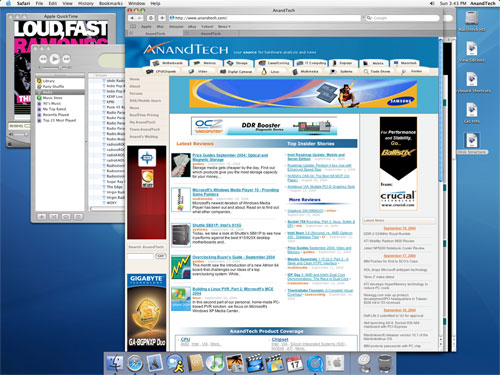
We start with our cluttered desktop...
Click to enlarge.
Hitting F9, for example, will cause Exposé to zoom out all of your active visible (unhidden) windows and essentially, tile them across your desktop. Then, using either the keyboard or the mouse, you can select the window that you want and everything goes back to normal, with the window that you have selected appearing in the foreground. The rest of the windows are untouched and are all in their original positions. The window that you selected is also in its original position; it is simply moved to the front so that you can see it.
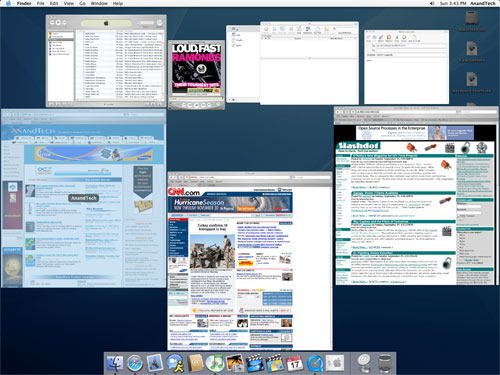
Hitting F9 activates Exposé across all applications.
Click to enlarge.
If you don't want to Exposé all windows, you can just Exposé the windows within a particular application (F10 by default), which is extremely handy for dealing with tons of images in Photoshop for example.
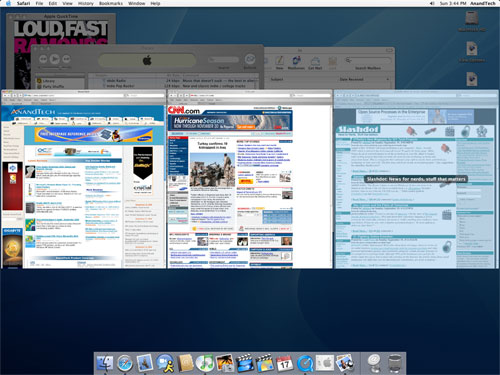
Hitting F10 activates Exposé across only a single application's windows.
Click to enlarge.
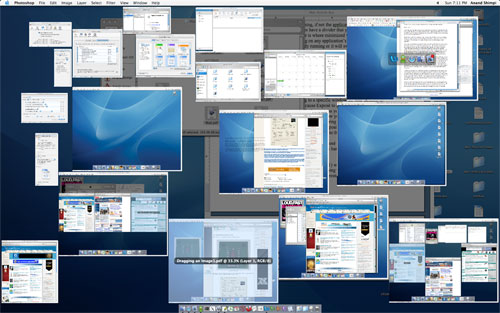
Another example of Exposé's usefulness in editing all of the images for this article in Photoshop.
Click to enlarge.
The final Exposé function lets you view your desktop (F11), which, to me, was like a more polished version of Windows-D, since after I was done doing whatever it is I needed to do on the desktop, Exposé deactivated and my screen was restored to its original state.
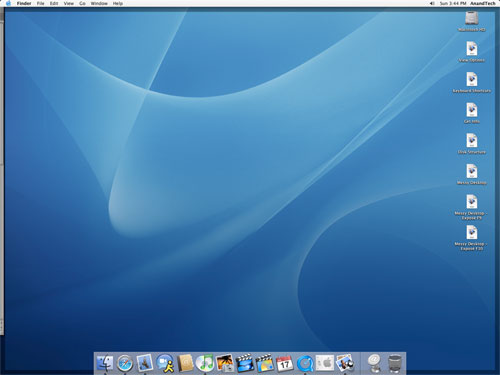
Hitting F11 reveals the desktop.
Click to enlarge.
The beauty of Exposé is difficult to convey in text alone. Honestly, the best way to evaluate it and understand its potential is to use it - luckily, there are Apple stores for this very purpose. Keep in mind that Exposé is very customizable as well and the three function keys that I mentioned above, although the defaults, are not the only ways that you can configure OS X to activate Exposé.
The benefits of Exposé are numerous. If you ever feel overwhelmed by having too many windows open, Exposé definitely alleviates that feeling as you don't have to tab through multiple applications to finally get to the window that you want. While Exposé does make having only a single display better, heavy multi-taskers will still enjoy the benefits of a dual display setup.
Since the OS X desktop environment is completely OpenGL accelerated, the performance of features like Exposé are not CPU limited - instead, they are GPU limited. Luckily, using Exposé with many windows open is not very stressful on even a Radeon 9600, but you do run out of video memory very quickly - in which case, your system ends up swapping to main memory over the AGP bus, making the Exposé animation considerably choppy. It seems that the sweet spot for more than a handful of windows open is around 128MB of video memory, with 256MB being perfect - needless to say, I found the mere 64MB that came on the Radeon 9600 which shipped with the system to be too little. There is no detriment to functionality if you don't have enough video memory; the Exposé animation simply becomes more choppy (which can be annoying on a $3000 system).










215 Comments
View All Comments
adt6247 - Friday, October 8, 2004 - link
#20 -- This was an article about Anand's "experience", which is hard to define. It wasn't a straight apples-to-apples comparison. He was going on his perception -- the perception of a PC user.Frankly, I'd love to own a Mac. I could never bring myself to buy an iMac (integrated monitor == BAD), and even the dual 1.8 is out of my price range. I'm more of a Linux kinda guy myself, but what I'd like a Mac for is professional audio/video apps, like ProTools. And OSX being BSD under the hood, I'd find it much more comfortable than Windows.
jecastej - Friday, October 8, 2004 - link
What I like about this article is the safe felling / deep thinking analisis. Not anybody hating anybody else because he/she picks a different flavor.As a Mac user who works in computer graphics who also uses a PC at work I constantly feel that the Mac is like a taboo for the PC world, and it should not be. I don't hate PCs, I just still prefer a Mac. And as a matter of fact I'm constantly reading articles in websites like Anandtech, because what I really love is technology and freedom.
If something else came out that I liked better and I could buy it I want to be free to choose, and to change my mind at any time.
So this is the intention of this community: That the user takes better well informed decisions.
jediknight - Friday, October 8, 2004 - link
#14: Not quite..1) Save memory use for 20 tabs vs. 20 windows
2) BUT, lose functionality to compare two webpages at the same time. The fact that a modal dialog in one tab stops you from switching tabs is very annoying.
3) Without extensions, switching between tabs uses a "dumb" behaviour.
Not to say that I don't like Firefox, but I don't find tabbed browsing to be as big a deal as some make it out to be.
GL - Friday, October 8, 2004 - link
brain29,I don't think Anand is being forced to upgrade. Any level-headed Mac user understands what he means regarding performance: his system is not Snappy (TM)! There are a few specific tasks, such as resizing a window, that are just sluggish under OS X. There are 2 ways to address this issue. One is by beefing up your hardware. Another is by optimizing your software.
OS X still has a ways to go before being fully optimized. In fact, the software is quite unoptimized which is why it can drag down a dual 2.0 GHz rig. The software code itself can be tightened up, and the compiler can be greatly improved. You have to remember that Apple uses gcc which has never been known to generate optimal PowerPC binaries, and they also use Objective-C which has not had as much attention given to it for performance improvements as other languages. 10.4 will be compiled with the newest gcc which has been tuned better to the PowerPC 970 and Objective-C.
With respect to text rendering speed, which may be at the heart of a lot of problems such as the Safari rendering speed, apparently optimizations are in the pipeline. Perhaps someone more "in the know" can elaborate or shoot down this, but I've heard that all text is rendered as bezier paths in OS X. Moreover, Quartz2D Extreme, while accelerating bezier path drawing quite nicely, did not speed up text rendering as much as it should have given that the text was just a special case of drawing bezier paths. This performance discrepancy is supposed to be addressed in 10.4.
Apple has consistently improved the speed of OS X by noticeable amounts with each point release. 10.3 was quite a bit faster than 10.2 which was quite a bit faster than 10.1 which was tremendously faster than 10.0. 10.4 is expected to keep up this tradition, and from what I've been told, it does address graphics rendering speed. Mind you this is speculation as I haven't used Tiger 10.4 and those that have are under NDA.
If I were Anand, I'd wait it out. I've used the new dual 2.5. It is noticeably faster than the dual 2.0. However, it is ever so slightly wanting in the Snappiness department. I suspect a dual 3.0 would finally be Snappy. At the same time, software improvements that should appear at the time the 3.0 is introduced might mean that you don't need such brute force to be Snappy. So Anand's dual 2.0 rig might inherit the Snappiness at some point in the not-so-distant future:-)
BTW, good job on the article Anand. With this subject, you really have to walk a fine line, and I think you did just that.
wilburpan - Friday, October 8, 2004 - link
Disclaimer: I've been a huge Mac fan since back in the day that 128 MB of RAM was considered enough for anyone. Overall, I thought this article was very well balanced in terms of how a Windows oriented user would look at a Mac system. There are two issues that I do have, however:1. "...we know our Windows servers, and we know what hardware works best under them, and thus, once assembled and properly maintained, we had no real issues with them." Using familiarity with Windows as a reason for preferring how Windows does things is not quite a valid argument. Substitute the word "BeOS" (to pick a neutral term) for Windows in the above sentence, and you'll see what I mean. For me, I am used to having the close window button in the upper left hand corner. Saying that this is an advantage for OS X because Windows puts the close window control on the other side would be equally invalid.
2. The issue of viruses and security is never raised. Regardless of the "security through obscurity" arguments people have raised, the fact remains that by their nature, OS X and other *nix-based OS'es are more secure than Windows. Of course, you can obtain a virus program and a firewall program and spend time maintaning those and reset the Windows defaults, but in OS X, you don't have to worry about those things. The criticism is often raised (justifiably) that Macs come underpowered, especially regarding the amount of RAM they are configured with, and complaints are made about the need to spend extra money for RAM. Why similar criticisms about the need to spend extra money for a virus program for Windows aren't similarly raised, especially since the cost of virus programs often are recurring (see Norton AntiVirus' subscription payments for virus definition updates).
CindyRodriguez - Friday, October 8, 2004 - link
#16.. you've never seen a Xeon or Opteron workstation? How many dual P4 or dual Athlon64 boxes have you seen? And don't get me started on comparative performance. G5 are faster than either in some benchmarks and they are slower in others. The PPC 970 is a good chip and if you are going to make comparisons vs. comparitive x86 hardware you should be fair.I imagine I've not shown you any problems with the article because you don't know the subject matter. I'm in a PC/Mac support office and we're all having a good chuckle about it.
#18.. My point isn't that it's a day outdated. My point is that Anand is doing a 1 month look back on a machine that was pulled off the market 3 months ago. My complaint is that though he acknowledges early that the machine has been rev'ed, he carries a tone through the piece that this is the latest greatest and it's not. Look at a dual 2.5 GHz G5 for $3K and compare it do a dual 2.4 GHz Opteron from a good vendor with a warranty and compare those too machines on price and performance. The Opteron will beat it in a lot of benchmarks (due to the rockin low latency mem controller) but It won't destroy the mac on price and I can still find benchmarks where the mac is faster.
My impression of the article is, Anand didn't bother to do any research and he provides backhanded digs when he has anything nice to say. I understand that the article is the Mac from a PC users perspective, but it would have been much better if he would have written the article as the novice, then did the research and fact checked it as a journalist.
raulmot - Friday, October 8, 2004 - link
Anand,You should try using the Mozilla Camino browser if you want a Mozilla based browser with the look and feel of OSX. It was built specifically for the Mac. Firefox added Mac support more as an afterthought.
That said, I don't use a Mac and don't know what your experience would be like, but I am an avid Firefox user and understand Camino may be more what you're looking for.
brain29 - Friday, October 8, 2004 - link
Of course the article is outdated. Even if he had written it yesterday it would have been outdated. Technology moves very fast nowadays. What's rediculous is that he has had his machine for however long and already you have given him reason to have to spend another 3 grand to upgrade. I know that if I spent that kind of money and found out that they upgraded my system. I'd be pissed. That's one reason I will probably never switch. I don't want to drop that cash on a rig and then be forced to do it again in 2 years. The thing that makes Mac's run so sweet, (proprietary hardware) is the thing that keeps me from gettin one. Ironic?GL - Friday, October 8, 2004 - link
Calm down Cindy,Regarding the .app bundles, you are correct. But I suspect Anand was misled by the installation of Office 2004. In grand Microsoft tradition, they decide to play by a different set of rules. Office installs as Anand suggests. But it's the only application that I know does. The rest are .app bundles like you say.
Anand,
Here's a keyboard tip. When you get to a dialog, you typically see 3 options: Cancel, an alternate choice (glowing but not highlighted, i.e. Do Not Save), and the default choice (highlighted, i.e. Save). Escape is for Cancel. Spacebar is for the alternate choice. Return is for the default choice.
Kishkumen - Friday, October 8, 2004 - link
#11 - Whoa, what? Since when is a G5 processor equivalent to a Xeon or Opteron? Anandtech is reviewing a workstation, not server.So far your quasi-flames have yet to convince me of one thing contrary to what Anand said in the article. In your own words you're nit-picking, not providing well-supported arguments to the contrary.